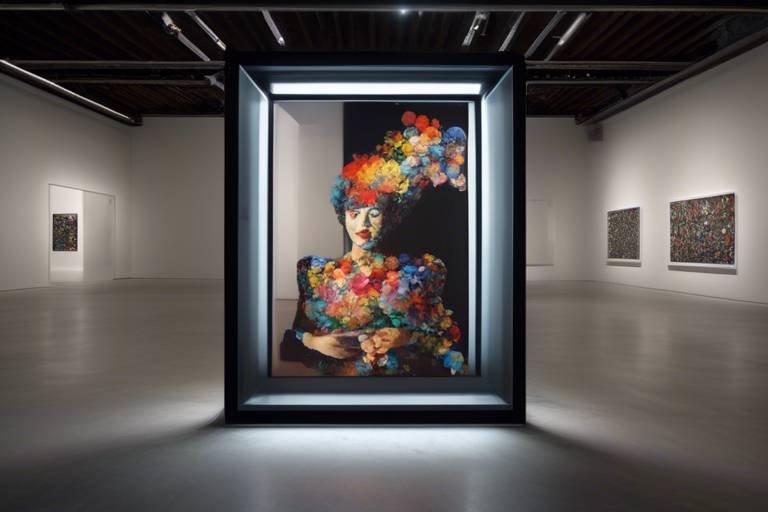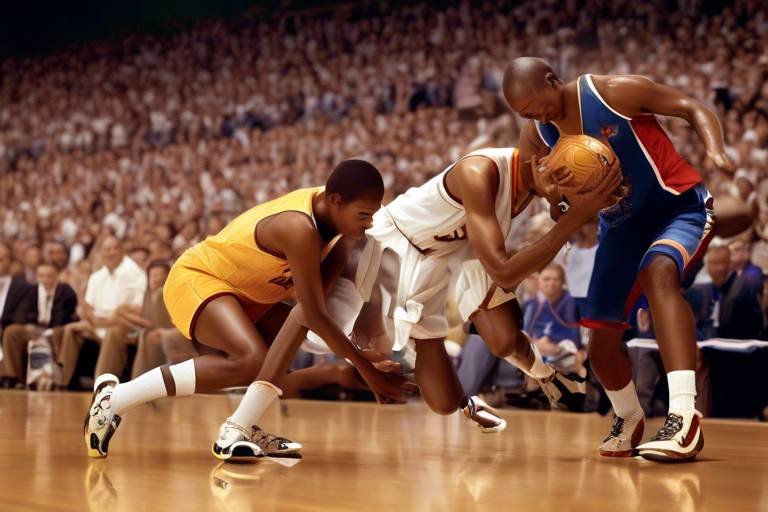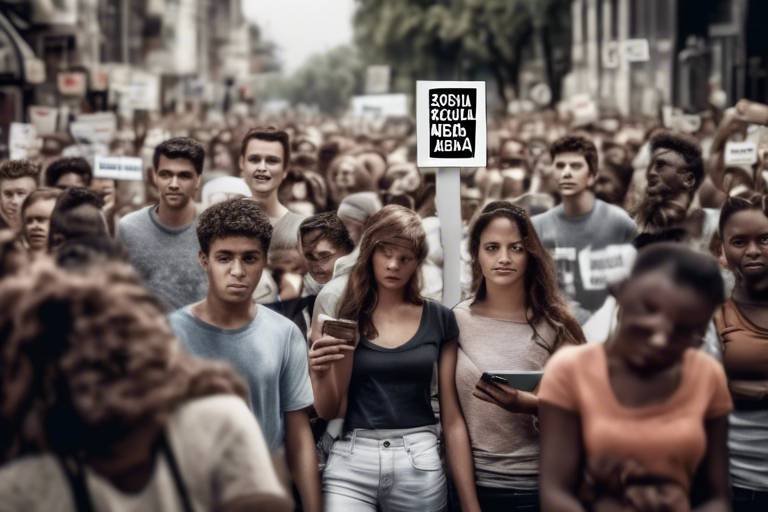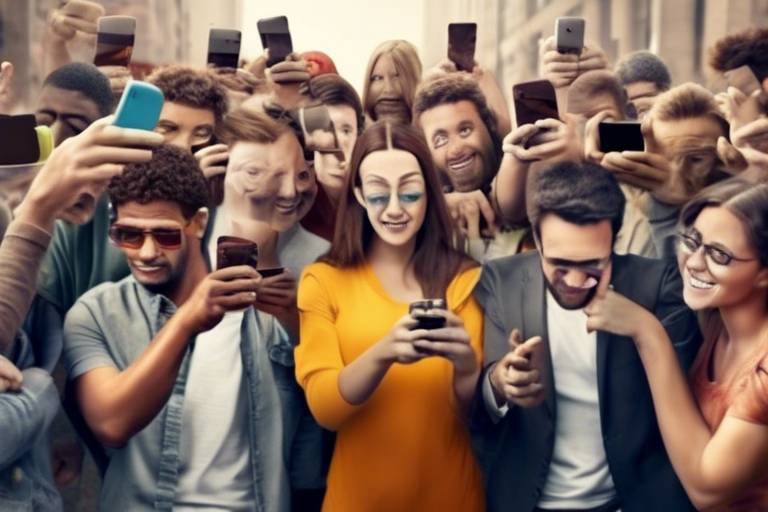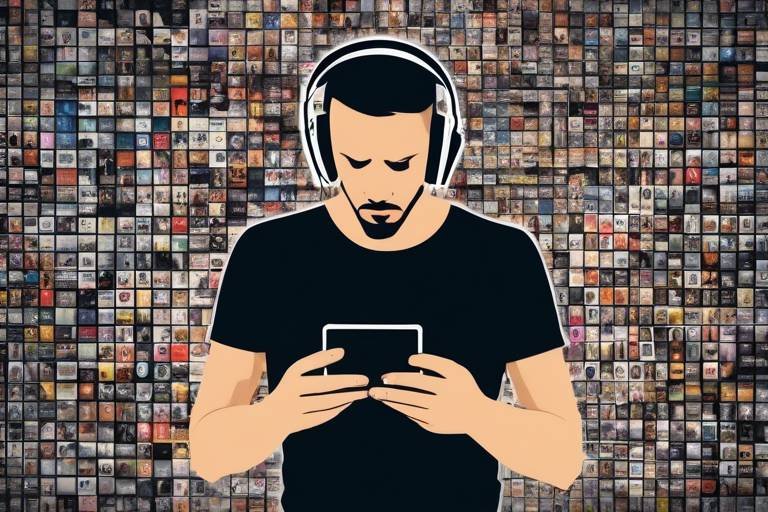How Technology is Changing the Landscape of Art
In today's fast-paced world, technology is not just a tool; it's a catalyst for transformation, especially in the realm of art. Gone are the days when art was confined to traditional canvases and galleries. The digital age has ushered in a new era where creativity knows no bounds, and artists are leveraging technology to push the envelope of what art can be. This article dives deep into the transformative impact of technology on the art world, highlighting emerging trends, innovative tools, and the evolving relationship between artists and their audiences in this digital age.
Digital art has gained immense popularity, enabling artists to create and share their work in innovative ways. From graphic design to 3D modeling, the evolution of digital art has significantly influenced contemporary culture. Artists are now able to explore new mediums and techniques, allowing for a more dynamic expression of their creativity. The significance of digital art lies not only in its aesthetic appeal but also in its accessibility. With just a few clicks, artists can reach a global audience, breaking down geographical barriers and democratizing the art world.
Virtual reality (VR) is revolutionizing how audiences experience art. Imagine stepping into a painting or being transported to a sculptural world where you can interact with the environment. This is the magic of VR, and artists are harnessing its potential to create immersive experiences that engage viewers on a deeper level. VR is not just about viewing art; it's about living it, feeling it, and becoming a part of it. This new dimension of art challenges traditional perceptions and invites audiences to explore creativity in unprecedented ways.
Interactive installations incorporate technology to allow audience participation, transforming passive viewers into active participants. This subsection explores how artists are using interactivity to enhance viewer engagement and create memorable experiences. By integrating sensors, touch screens, and even artificial intelligence, artists can create environments that respond to the audience's actions. This interaction can evoke emotions, provoke thoughts, and foster a deeper connection between the viewer and the artwork.
Examining notable interactive art installations reveals the potential of technology to transform traditional art forms and captivate audiences. For instance, the installation "The Obliteration Room" by Yayoi Kusama invites viewers to cover a white room with colorful dot stickers, turning a blank canvas into a vibrant explosion of color. Such installations not only engage the audience but also create a communal experience that fosters creativity and collaboration.
While interactivity offers new possibilities, it also presents challenges for artists. Striking the right balance between technology and artistic intent is crucial. Artists must consider how much interactivity enhances the experience without overshadowing the artwork itself. Additionally, technical glitches and user experience can impact how audiences perceive and interact with the art. Navigating these challenges requires a thoughtful approach, ensuring that technology serves as a bridge to deeper artistic expression rather than a barrier.
Augmented reality (AR) blends digital elements with the physical world, creating a unique fusion that enhances traditional artworks. Artists use AR to overlay digital images, animations, or information onto physical pieces, offering viewers a multi-layered experience. This technology allows for storytelling in ways that were previously unimaginable, inviting audiences to engage with art beyond the visual. Imagine pointing your smartphone at a painting and watching it come to life with animations that tell a story or reveal hidden details. The potential for creativity is limitless!
Technology is reshaping the art market, from online galleries to blockchain. The traditional methods of buying and selling art are evolving, making the process more transparent and accessible. This section explores how these advancements are changing how art is bought, sold, and valued. With the rise of online platforms, artists can showcase their work to a global audience, while collectors can discover new talent without the constraints of physical galleries.
The rise of online platforms has made art more accessible than ever. Artists can now sell their work through various digital marketplaces, reaching collectors who may have never set foot in a gallery. This shift has implications for both artists and collectors alike. It allows artists to retain more control over their sales and pricing, while collectors benefit from a wider selection of artwork at their fingertips. However, this also means increased competition, as artists vie for attention in a crowded online space.
Blockchain technology is revolutionizing art authentication and provenance, ensuring transparency and trust in art transactions. By creating a secure digital ledger, blockchain allows artists to verify the authenticity of their work, which is crucial in a market often plagued by forgery. This technology not only protects artists but also reassures collectors that they are investing in genuine pieces. As the art world continues to embrace blockchain, we can expect a more secure and trustworthy marketplace.
- What is digital art? Digital art refers to artworks created or presented using digital technology, including graphic design, digital painting, and 3D modeling.
- How is virtual reality used in art? VR allows artists to create immersive environments that engage viewers, transforming the way art is experienced.
- What are interactive installations? These are art pieces that require audience participation, often using technology to enhance the experience.
- How does blockchain benefit the art market? Blockchain provides a secure way to authenticate art, ensuring transparency in transactions and protecting artists from forgery.

The Rise of Digital Art
Digital art is not just a trend; it's a revolution that has transformed the way we perceive and interact with art. In the past, artists were often confined to traditional mediums like painting and sculpture, but now, with the advent of technology, the canvas has expanded beyond physical boundaries. Imagine a world where your imagination can be brought to life with just a few clicks! This is the essence of digital art, where creativity meets technology in an exhilarating dance of pixels and colors.
As we delve into the evolution of digital art, it’s essential to recognize its significance in contemporary culture. Digital art encompasses a variety of forms, including digital painting, 3D modeling, and even generative art created by algorithms. Artists today are equipped with powerful tools that allow them to explore new dimensions of creativity. Programs like Adobe Photoshop and Procreate have become staples in the artist's toolkit, enabling them to push the limits of their imagination.
One of the most fascinating aspects of digital art is its accessibility. With the internet at our fingertips, artists can share their work with a global audience instantly. This democratization of art has led to a surge in online platforms where artists can showcase their creations, such as Instagram, DeviantArt, and Behance. No longer do artists need to rely solely on galleries to display their work; they can now build their own following and connect directly with fans. This shift has not only empowered artists but has also allowed audiences to discover new talents from every corner of the globe.
Moreover, the rise of digital art has paved the way for innovative collaborations between artists and technologists. For instance, many artists are now experimenting with virtual reality (VR) and augmented reality (AR) to create immersive experiences that captivate audiences. Imagine walking through a gallery where the paintings come to life, or using your smartphone to see additional layers of a piece that aren’t visible to the naked eye. These technologies are not just enhancing the viewer's experience; they are fundamentally changing what art can be.
As digital art continues to evolve, it raises intriguing questions about the nature of art itself. Is a digital painting any less valuable than a traditional one? Can we consider a piece of code as art? These questions challenge our perceptions and encourage us to rethink the definitions and boundaries of artistic expression. In this digital age, the lines are blurred, and the possibilities are endless.
In conclusion, the rise of digital art is a testament to the power of technology in shaping our creative landscapes. It invites us to explore, engage, and experience art in ways we never thought possible. As we look to the future, one thing is clear: digital art is not just here to stay; it's poised to redefine what art means in the 21st century.

Virtual Reality in Art
Virtual reality (VR) is not just a buzzword; it’s a game-changer in the art world. Imagine stepping into a painting, where the colors swirl around you, and you can interact with the elements as if they were alive. This technology is creating immersive experiences that traditional art forms simply cannot offer. Artists are harnessing VR to transport viewers into their creative minds, allowing them to experience art in ways that were once unimaginable. It’s like taking a stroll through a dream where the boundaries of reality are blurred, and the only limit is the artist's imagination.
The evolution of VR in art has opened up a plethora of possibilities. Artists can now create entire worlds that viewers can explore, turning the act of viewing art into an interactive adventure. This shift from passive observation to active participation is reshaping the relationship between the artist and the audience. No longer are viewers just spectators; they are now participants in the artistic narrative. This engagement can lead to a deeper emotional connection with the artwork, as audiences become part of the story being told.
One of the most fascinating aspects of VR in art is the ability to create multi-sensory experiences. Artists can incorporate sound, movement, and even touch into their virtual environments. For example, consider a VR installation where you can hear the rustling of leaves as you walk through a digital forest, or feel the sensation of floating in a cosmic space. These elements can evoke emotions that traditional art forms might struggle to convey. It’s like comparing a static photograph to a dynamic film—the latter can tell a story in ways that the former cannot.
However, the integration of VR into the art world is not without its challenges. Artists must navigate the technical aspects of VR creation while maintaining their artistic vision. This balance can be tricky; after all, how do you ensure that the technology enhances the art rather than overshadows it? Additionally, there’s the question of accessibility. While VR can create stunning experiences, not everyone has access to the necessary technology. This raises important discussions about inclusivity in the art world and how to make these experiences available to a broader audience.
As we look to the future, it’s clear that VR will continue to play a significant role in the evolution of art. The potential for collaboration between artists and technologists could lead to even more groundbreaking creations. Imagine a world where artists can collaborate with programmers to create art that evolves and changes based on viewer interactions. The possibilities are endless, and it’s an exciting time to be an artist or an art lover.
In conclusion, virtual reality is not just a trend; it’s a transformative force in the art world. It’s reshaping how we create, experience, and interact with art. As artists continue to push the boundaries of this technology, we can expect to see even more innovative and engaging experiences that challenge our perceptions of what art can be. So, the next time you find yourself in a VR art installation, remember that you’re not just an observer; you’re part of a revolution in the way we understand and appreciate art.

Interactive Installations
In the vibrant world of contemporary art, have emerged as a groundbreaking way to engage audiences. These installations invite viewers to step beyond the role of passive observers and become active participants in the artistic experience. Imagine walking into a gallery where the art responds to your movements, or where your choices influence the outcome of a digital narrative. This is the essence of interactivity in art—it's not just about looking; it's about experiencing.
Artists are leveraging technology to create these immersive environments that blur the lines between art and audience. For example, installations may incorporate sensors that detect motion, allowing the art to change based on how people interact with it. This dynamic relationship transforms the viewing experience into a dialogue, where the audience's presence is integral to the artwork's existence. Such installations can evoke a range of emotions, from joy and wonder to introspection and contemplation.
One of the most exciting aspects of interactive installations is their ability to foster community engagement. Consider a public art project where individuals can contribute their own digital artwork to a collective display. This not only democratizes art but also creates a sense of ownership and connection among participants. The art becomes a living entity, constantly evolving with each interaction. As a result, the installation can reflect the diverse voices and experiences of the community it serves.
However, the creation of these interactive experiences does come with its own set of challenges. Artists must carefully balance technology and artistic intent. Too much reliance on technology can overshadow the message or theme of the artwork, leading to a disconnection between the viewer and the intended experience. Artists often grapple with questions like: How do I ensure that the technology enhances rather than detracts from the art? How can I maintain the integrity of my vision while embracing new tools? These are critical considerations that shape the development of interactive installations.
In summary, interactive installations represent a thrilling frontier in the art world. They not only redefine how we engage with art but also challenge traditional notions of authorship and creativity. As technology continues to evolve, so too will the possibilities for artists to create experiences that resonate with audiences on a deeper level. The future of art is not just to be seen; it is to be felt, shared, and co-created.
- What are interactive installations?
Interactive installations are artworks that require audience participation, allowing viewers to engage with the art in dynamic ways.
- How do artists create these installations?
Artists use various technologies, including sensors, projection mapping, and digital interfaces, to create responsive environments.
- What are the benefits of interactive art?
Interactive art fosters engagement, encourages community participation, and creates memorable experiences that resonate with viewers.
- Are there any challenges associated with interactive installations?
Yes, artists must balance technology and artistic intent to ensure that the interactive elements enhance rather than detract from the artwork.

Case Studies of Successful Installations
When we delve into the world of interactive art installations, a few standout projects truly exemplify how technology can create unforgettable experiences for audiences. One prime example is the installation titled "TeamLab Borderless," which is located in Tokyo, Japan. This immersive experience is a collaboration between art and technology, where visitors wander through a digital universe that reacts to their movements. Imagine walking through a room where the walls are alive with changing colors and shapes, all responding to your presence. This installation seamlessly blends art with technology, making every visitor's experience unique and personal.
Another remarkable case study is "The Obliteration Room" by Yayoi Kusama. Initially a pristine white room filled with white furniture, this installation invites visitors to transform the space by adding colorful dot stickers. As more and more people participate, the room evolves into a vibrant explosion of colors, showcasing the power of collective creativity. This installation not only engages the audience but also emphasizes the theme of transformation, illustrating how art can change in response to human interaction.
Furthermore, consider "Rain Room" by Random International, where visitors walk through a downpour of water without getting wet. This installation uses advanced motion sensors to detect the presence of people, allowing them to move freely while the rain pauses in their vicinity. It’s a stunning example of how technology can create a dialogue between the viewer and the artwork, evoking feelings of wonder and amazement. The experience is not just about observing art; it's about being part of it, making it a memorable encounter.
These installations highlight a significant trend in contemporary art: the shift from passive observation to active participation. As artists continue to experiment with technology, they open up new avenues for engagement, transforming the way we experience art. The use of interactive elements not only captivates audiences but also fosters a deeper emotional connection to the artwork. However, it’s essential to recognize that while technology enhances these experiences, it must be carefully balanced with the artist's original intent to maintain the integrity of the art form.
In summary, successful interactive installations like TeamLab Borderless, The Obliteration Room, and Rain Room showcase the incredible potential of technology in the art world. They invite audiences to engage, participate, and transform their surroundings, ultimately redefining the relationship between art and viewer. As we continue to explore these innovative pathways, the future of art looks not only exciting but also deeply intertwined with the technological advancements that shape our lives.
- What is an interactive art installation?
Interactive art installations are artworks that require the participation of the audience, allowing them to engage directly with the piece, often altering its appearance or experience in real-time.
- How does technology influence modern art?
Technology influences modern art by providing new tools for creation and new platforms for sharing and experiencing art, enabling artists to push boundaries and explore innovative concepts.
- Can anyone participate in interactive installations?
Yes! Interactive installations are designed to be accessible to everyone, encouraging participation from a wide range of audiences, regardless of their background or familiarity with art.

Challenges of Interactivity
As the world of art embraces the thrilling realm of interactivity, it's essential to recognize that this innovative approach comes with its own set of challenges. While the idea of allowing audiences to engage directly with art is exciting, it raises questions about the balance between technology and artistic intent. Artists must navigate a complex landscape where the tools for interactivity can sometimes overshadow the message they wish to convey. Imagine a painter who has spent years perfecting their craft only to find that their work is reduced to a mere gimmick because of an overreliance on technology. This scenario is not far-fetched in today's digital age.
One significant challenge is ensuring that the technology enhances rather than detracts from the artistic experience. For instance, an interactive installation might require a sophisticated setup that could malfunction, leaving viewers frustrated instead of engaged. This leads to a critical question: how can artists maintain the integrity of their work while incorporating interactive elements? The answer lies in a careful balance. Artists need to be intentional about how they use technology, ensuring it serves the artwork's narrative rather than becoming the focal point.
Moreover, interactivity can sometimes alienate certain audience members. Not everyone is comfortable with technology, and some may feel intimidated by the prospect of participating in an interactive experience. This can create a divide between those who embrace the digital age and those who prefer traditional forms of art. To combat this, artists must consider accessibility in their designs, making sure that everyone has the opportunity to engage with their work, regardless of their tech-savviness.
Another challenge is the potential for misinterpretation. When viewers interact with a piece of art, they bring their own experiences and biases into the equation, which can lead to varied interpretations. While this diversity of thought is a beautiful aspect of art, it can also complicate the artist's original message. Artists may need to think critically about how to guide their audience's experience while still allowing for personal interpretation.
In summary, the challenges of interactivity in art are multifaceted. Artists must grapple with the following key issues:
- Maintaining Artistic Integrity: Ensuring technology supports rather than overshadows the artwork.
- Audience Accessibility: Designing experiences that are inclusive for all audience members.
- Interpretation Variability: Managing the risk of misinterpretation while encouraging personal engagement.
As artists continue to explore interactive installations, it's crucial to address these challenges thoughtfully. By doing so, they can create meaningful experiences that resonate with audiences while preserving the essence of their artistic vision.
Q: What are some examples of interactive art installations?
A: Some notable examples include teamLab Borderless in Tokyo, which features immersive digital art that responds to viewer interactions, and the "The Obliteration Room" by Yayoi Kusama, where visitors can add colorful dot stickers to a completely white room, transforming it into a vibrant space.
Q: How can artists ensure their interactive art is accessible?
A: Artists can ensure accessibility by incorporating user-friendly interfaces, providing clear instructions, and considering the physical and cognitive needs of their audience. This may include offering alternative ways to engage with the artwork for those who may not be tech-savvy.
Q: Can interactive art still convey a strong message?
A: Absolutely! Interactive art can enhance the message by inviting viewers to participate in the narrative. However, artists must be deliberate in their approach to maintain the integrity of their message amidst the interactive elements.

Augmented Reality and Art
Augmented Reality (AR) is like a magic window that lets us see the world in a whole new light. Imagine walking through a gallery and suddenly, the paintings start to come alive! This is the power of AR in the art world, where digital elements are layered over physical artworks, creating a dynamic interaction that wasn't possible before. Artists are now able to merge the tangible with the virtual, offering viewers an experience that transcends traditional boundaries. It's not just about seeing art anymore; it's about experiencing it.
One of the most exciting aspects of AR is its ability to engage audiences in ways that are both personal and profound. For instance, with a simple scan of a smartphone, a viewer can unlock hidden layers of information about the artwork, such as the artist's inspiration or the techniques used. This interactive experience fosters a deeper connection between the viewer and the artwork, turning passive observation into active participation. Think of it as a conversation between the artwork and the audience, where each interaction reveals more about the piece and its creator.
Moreover, AR is being used to create entirely new forms of art. Artists are experimenting with digital overlays that complement or contrast with their physical pieces. This fusion not only enhances the visual experience but also challenges our perceptions of what art can be. For example, an artist might create a mural that, when viewed through an AR app, reveals animated elements that tell a story or evoke an emotion. The result is an artwork that evolves with each viewing, making every experience unique and memorable.
However, the integration of AR into art is not without its challenges. Artists must navigate the technical aspects of AR development, which can be daunting. They need to consider how the digital elements will interact with the physical space and ensure that the technology enhances rather than distracts from the artwork's message. This delicate balance between technology and artistic intent is crucial. As artists explore these new frontiers, they are not just creating art; they are also becoming tech-savvy innovators.
To illustrate the impact of AR on the art world, consider a few notable examples:
| Artist | Artwork | AR Experience |
|---|---|---|
| Kara Walker | “A Subtlety” | Viewers used AR to see animated elements that highlighted themes of race and history. |
| Yayoi Kusama | “Infinity Mirror Rooms” | AR app allowed visitors to create their own virtual infinity rooms. |
| Refik Anadol | “Archive Dreaming” | Digital sculptures that change based on viewer interaction. |
As we continue to embrace technology in art, the possibilities are endless. AR is not just a trend; it's a revolution that is reshaping how we create, view, and interact with art. It's an exciting time to be an artist or an art lover, as the lines between the real and the virtual blur, allowing for an enriched experience that captivates the imagination.
- What is Augmented Reality in art? Augmented Reality in art combines digital elements with physical artworks, creating an interactive experience for viewers.
- How do artists use AR? Artists use AR to enhance their work, providing additional layers of information and creating immersive experiences that engage the audience.
- Are there any challenges associated with AR in art? Yes, artists must balance the technical aspects of AR with their artistic vision to ensure that the technology enhances rather than distracts from the artwork.
- Can anyone access AR art experiences? Most AR experiences can be accessed through smartphones or tablets, making them widely available to the public.

Art Market and Technology
The art market has undergone a remarkable transformation in recent years, primarily driven by advancements in technology. Gone are the days when art was confined to physical galleries and auction houses. Today, artists and collectors alike are embracing the digital realm, where the boundaries of creativity and commerce blur. The rise of online platforms has not only democratized access to art but has also redefined how art is bought, sold, and valued. Imagine scrolling through a virtual gallery from the comfort of your home, discovering pieces that resonate with you, and purchasing them with just a click. This is the new reality of the art market, and it’s as exciting as it is revolutionary.
One of the most significant changes in the art market is the emergence of online art sales. Platforms like Artsy, Saatchi Art, and even social media channels have created new avenues for artists to showcase their work to a global audience. This shift has made art more accessible than ever before, allowing emerging artists to reach potential buyers without the need for a traditional gallery representation. Think about it: an artist in a small town can now sell their work to a collector in a bustling city halfway across the world. This connectivity is reshaping the landscape of art commerce.
However, with this accessibility comes a new set of challenges. The art market has always been a complex ecosystem, and the influx of online sales has led to questions about authenticity and value. This is where blockchain technology steps in, providing a solution that enhances transparency and trust in art transactions. By utilizing blockchain, artists can create a verifiable digital record of their work, ensuring that the provenance of each piece is secure and easily traceable. This technology not only protects artists from fraud but also gives buyers peace of mind when investing in art.
| Technology Impact | Description |
|---|---|
| Online Sales Platforms | Increased accessibility and global reach for artists and collectors. |
| Blockchain | Provides secure authentication and provenance tracking for artworks. |
| Social Media | Facilitates direct engagement between artists and audiences. |
Moreover, the integration of technology into the art market is not just about convenience; it's also about innovation. Artists are now experimenting with digital mediums and creating NFTs (non-fungible tokens), which have taken the art world by storm. NFTs allow artists to sell their digital works in a way that ensures scarcity and ownership, creating a new revenue stream that was previously unimaginable. This phenomenon has sparked a debate about the value of digital art, challenging traditional notions of what constitutes 'art' and how it should be valued.
In conclusion, the intersection of art and technology is creating a dynamic environment that is reshaping the art market. As artists continue to explore new digital frontiers and collectors adapt to the evolving landscape, the future of art commerce looks bright. The question remains: how will these changes continue to impact the way we perceive and value art in the years to come? Only time will tell, but one thing is for certain: the art world is in the midst of a thrilling revolution.
- How has technology changed the way art is sold? Technology has introduced online platforms that allow artists to reach a global audience, making art more accessible to collectors.
- What role does blockchain play in the art market? Blockchain ensures the authenticity and provenance of artworks, providing transparency in transactions and protecting artists from fraud.
- What are NFTs and why are they important? NFTs are digital tokens that represent ownership of a unique digital asset, allowing artists to sell their digital works securely.

Online Art Sales
The digital revolution has fundamentally transformed the way art is bought and sold, and one of the most significant developments in this realm is the rise of . Gone are the days when collectors had to visit galleries or auction houses to find their next prized piece. Now, with just a few clicks, art enthusiasts can explore a vast array of artworks from the comfort of their homes. This shift not only broadens the market for artists but also democratizes art access for collectors and casual buyers alike.
One of the key advantages of online art sales is the ability to reach a global audience. Artists can showcase their work on various platforms, allowing them to connect with buyers from different corners of the world. This exposure can lead to increased sales and recognition, especially for emerging artists who may not have the resources to participate in traditional art fairs or exhibitions. Moreover, the convenience of online shopping means that collectors can browse and purchase art at any time, making it easier to find that perfect piece that resonates with them.
However, this new landscape is not without its challenges. With so many platforms available, buyers may feel overwhelmed by the sheer volume of options. To help navigate this digital marketplace, here are a few considerations to keep in mind:
- Research the Platform: Not all online art platforms are created equal. Some specialize in contemporary art, while others may focus on classical pieces. Understanding the platform's niche can help buyers make more informed decisions.
- Verify Authenticity: In an age where reproductions are common, ensuring that a piece is authentic is crucial. Many reputable online galleries provide certificates of authenticity or detailed provenance to reassure buyers.
- Engage with Artists: Many platforms allow direct communication with artists. Engaging with them can provide insights into their creative process and the story behind their work, enhancing the overall buying experience.
Additionally, the use of technology in online art sales has led to innovative solutions such as virtual exhibitions and 3D viewing experiences. These features allow potential buyers to experience the art in a more immersive way, somewhat akin to visiting a physical gallery. Imagine being able to see how a painting looks on your wall through augmented reality before making a purchase! This not only enhances the shopping experience but also builds trust between the buyer and the seller.
As we look towards the future, it's clear that online art sales will continue to evolve. The integration of social media into the art market is another exciting trend. Artists and galleries are increasingly using platforms like Instagram to showcase their work, engage with audiences, and drive sales. This shift toward social commerce is reshaping how art is marketed and sold, making it more interactive and community-driven.
In summary, the rise of online art sales represents a dynamic shift in the art world. While it presents certain challenges, the opportunities for artists and collectors are immense. As technology continues to advance, we can expect even more innovative ways to buy and sell art, making the experience more accessible and enjoyable for everyone involved.
1. How do I know if an online art platform is reputable?
It's essential to research the platform's history, read reviews, and check for any affiliations with established art organizations. Reputable platforms often provide detailed information about their artists and artworks.
2. Can I return artwork purchased online?
Return policies vary by platform, so it's important to review the specific terms before making a purchase. Many reputable galleries offer return options if the artwork does not meet your expectations.
3. What should I look for when buying art online?
Consider factors such as the artist's background, the authenticity of the piece, and how it fits into your collection. Engaging with the artist or gallery can also provide valuable insights.
4. Is it safe to buy art online?
Yes, as long as you use reputable platforms that prioritize security and provide clear information about their policies. Always ensure that payment methods are secure.

Blockchain and Art Authentication
The art world has long grappled with issues of authenticity and provenance. Imagine purchasing a stunning painting, only to later discover that it’s a forgery. This fear has haunted collectors and artists alike, leading to a growing need for reliable verification methods. Enter blockchain technology, a game-changer that is redefining how we authenticate art. By providing a decentralized and transparent ledger, blockchain ensures that every transaction and ownership history is securely recorded and easily accessible.
At its core, blockchain is a digital ledger that records transactions across many computers in such a way that the registered transactions cannot be altered retroactively. This characteristic makes it incredibly useful for art authentication. Each piece of art can be assigned a unique digital certificate stored on the blockchain, which includes vital information such as the artist’s name, the artwork’s history, and previous owners. This not only helps in verifying authenticity but also adds a layer of trust for buyers and sellers.
Consider this: when an artwork is sold, the transaction is recorded on the blockchain, creating an immutable record. This means that anyone can trace the history of the artwork back to its origin. For artists, this is a powerful tool; they can prove their authorship and maintain control over their work, even after it changes hands. Moreover, collectors can confidently invest in pieces, knowing that the provenance is verifiable. The implications for the market are profound, as buyers are more likely to invest in art that comes with a clear and trustworthy history.
| Benefits of Blockchain in Art Authentication | Description |
|---|---|
| Transparency | Every transaction is recorded and can be viewed by anyone, reducing the chances of fraud. |
| Security | Data stored on the blockchain is encrypted and nearly impossible to alter, ensuring the integrity of information. |
| Ownership Tracking | Blockchain allows for easy tracking of ownership history, confirming authenticity and provenance. |
| Artist Royalties | Smart contracts can ensure that artists receive royalties on future sales of their work. |
Despite the numerous advantages, the integration of blockchain into the art world is not without challenges. One significant hurdle is the need for widespread adoption among artists, galleries, and collectors. Many in the traditional art market may be hesitant to embrace this technology due to a lack of understanding or fear of change. Furthermore, there are questions surrounding the environmental impact of blockchain, particularly in terms of energy consumption associated with certain blockchain networks.
Nevertheless, as more artists and collectors recognize the benefits, the momentum for blockchain adoption in art authentication is likely to grow. It's an exciting time for the art world, as technology continues to blur the lines between creativity and innovation. The future holds the promise of a more transparent, secure, and equitable art market, where authenticity is no longer a concern but a guarantee.
- What is blockchain technology? Blockchain is a decentralized digital ledger that records transactions across multiple computers, ensuring that the data cannot be altered retroactively.
- How does blockchain help in art authentication? It provides a secure and transparent way to track the history and ownership of art pieces, making it easier to verify authenticity.
- Are there any challenges with using blockchain in art? Yes, challenges include the need for widespread adoption and concerns about the environmental impact of certain blockchain technologies.
- Can artists benefit from blockchain? Absolutely! Artists can prove their authorship, maintain control over their work, and even earn royalties through smart contracts.
Frequently Asked Questions
- What is digital art and why is it important?
Digital art refers to artistic works created using digital technology. It's important because it allows artists to explore new mediums and share their work globally, breaking down traditional barriers in the art world.
- How is virtual reality changing the way we experience art?
Virtual reality immerses viewers in a 3D environment, allowing them to engage with art in a way that feels almost real. It transforms the passive experience of viewing art into an active one, where audiences can interact and explore.
- What are interactive installations?
Interactive installations are artworks that require audience participation. They use technology to create engaging environments where viewers can influence the artwork, making each experience unique and memorable.
- What challenges do artists face with interactive art?
Artists must balance their creative vision with the technical aspects of interactivity. They need to ensure that technology enhances the artwork rather than distracts from it, which can be a tricky line to walk.
- How does augmented reality enhance traditional art?
Augmented reality overlays digital information onto the physical world, allowing artists to add layers of meaning to their work. This can create a richer experience for viewers, merging the real and digital in exciting ways.
- What impact has technology had on the art market?
Technology has revolutionized the art market by introducing online galleries and digital sales platforms. This has made art more accessible to a wider audience and changed how artists and collectors interact.
- How does blockchain technology affect art authentication?
Blockchain provides a secure and transparent way to verify the authenticity and provenance of artworks. This technology helps prevent fraud and builds trust in art transactions, which is crucial for collectors and investors.
- Are online art sales beneficial for artists?
Absolutely! Online platforms allow artists to reach a global audience, increase their visibility, and sell their work directly to collectors without the need for traditional galleries, which can take a significant cut of the profits.

